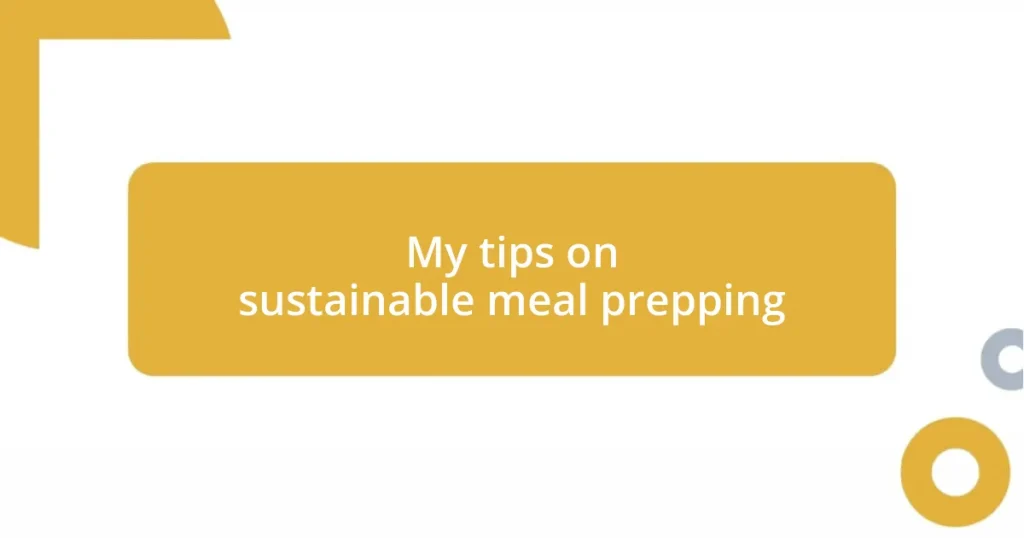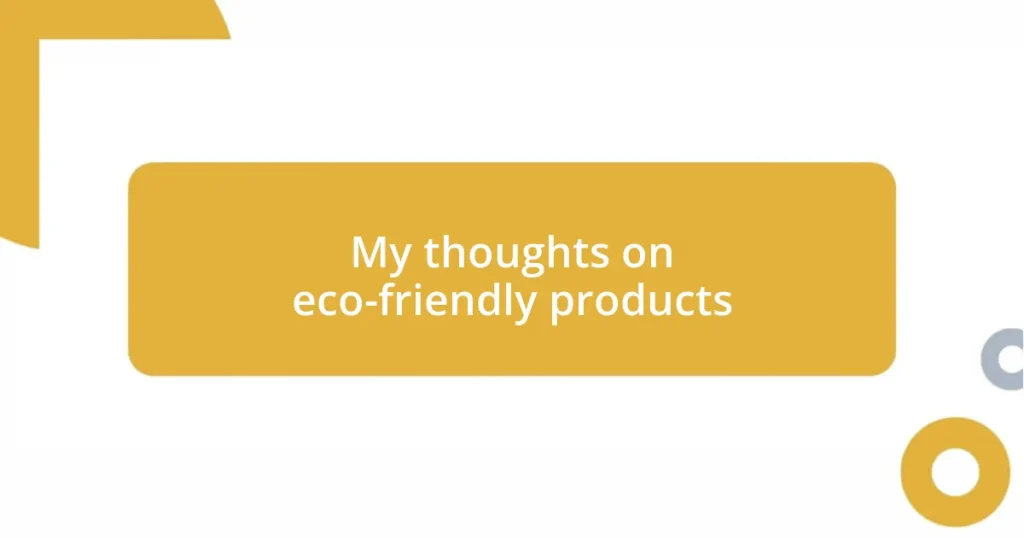Key takeaways:
- Sustainable meal prepping focuses on mindful food choices that benefit both personal health and the environment.
- Key benefits of meal prepping include waste reduction, cost savings through bulk purchasing, and enhanced culinary creativity.
- Choosing seasonal and local ingredients supports farmers, fosters community, and minimizes the carbon footprint.
- Effective meal prep involves efficient planning, proper storage techniques, and repurposing leftovers to reduce waste.
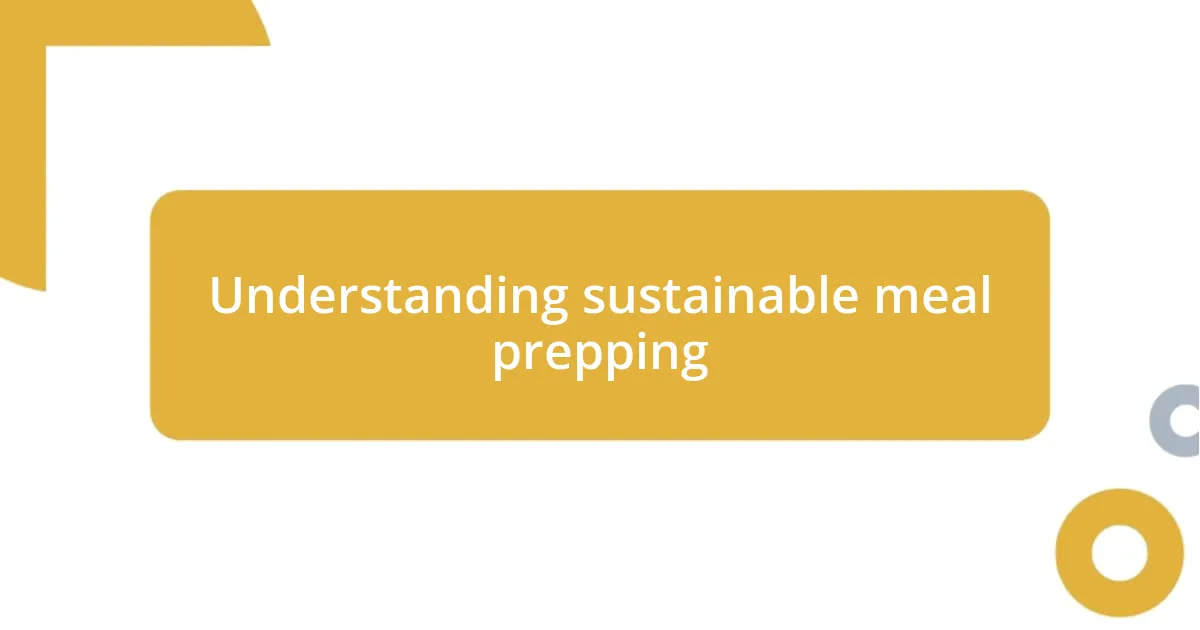
Understanding sustainable meal prepping
Sustainable meal prepping goes beyond just making food in advance; it’s about making mindful choices that benefit our health and the planet. I remember the first time I transitioned to a more sustainable approach – I felt empowered knowing my food decisions could help reduce waste and support local farmers. It’s in those moments, while chopping fresh veggies, that I realized how my habits could align with my values.
When I think about sustainable meal prepping, I can’t help but ask: what does my food really impact? Each ingredient we choose has a story, from its source to its journey to our kitchens. I once tracked the origins of my produce and was surprised to find that the simple act of buying local not only tastes better but also cuts down on carbon emissions associated with transportation.
Incorporating sustainability doesn’t mean sacrificing flavor or convenience. I often batch cook grains and legumes, which have low environmental footprints, and then mix them with seasonal veggies. This approach not only deliciously diversifies my meals but also helps me stay mindful of what I consume, ultimately leading to a more enjoyable and fulfilling dining experience. Isn’t it satisfying to know that every meal is both nourishing for us and considerate of the earth?
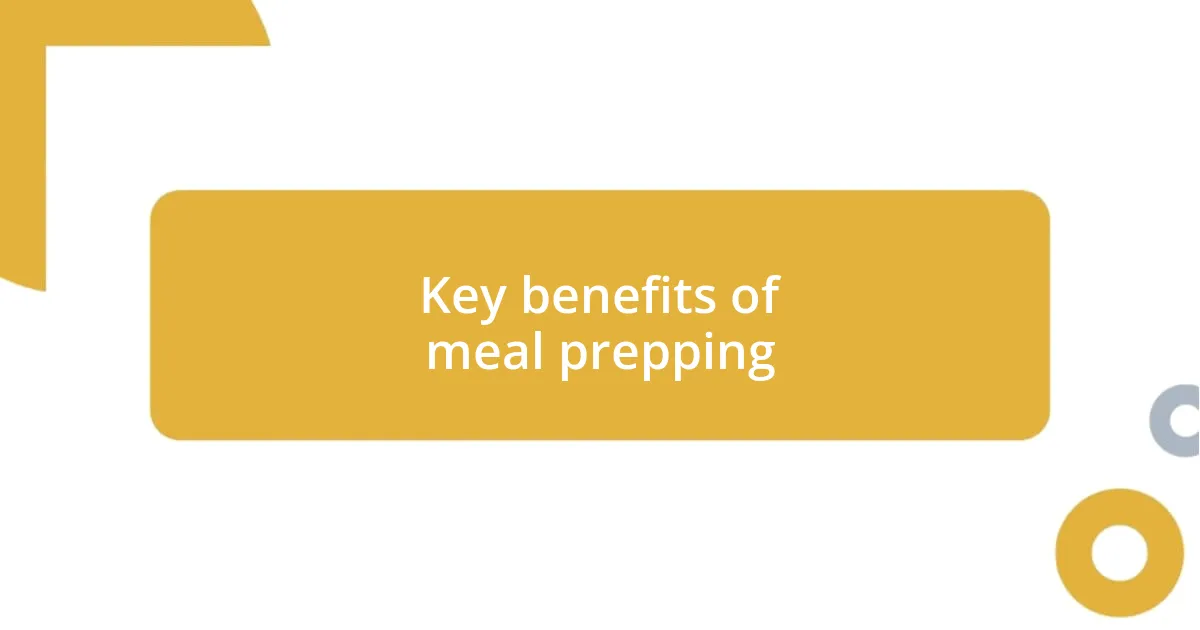
Key benefits of meal prepping
Meal prepping isn’t just about saving time; it’s also a fantastic way to minimize food waste. In my own experience, pre-planning meals helps ensure that I use up ingredients before they spoil. This conscious approach not only feels responsible but also gives me a sense of pride when I manage to avoid throwing away produce that I’ve lovingly picked out from the farmer’s market.
Another remarkable benefit is the financial savings I’ve observed over time. When I plan meals in advance, I can buy ingredients in bulk, which often comes at a lower cost. I remember the first month I tried this method; I was amazed to see how much I saved on my grocery bill, allowing me to indulge in a few premium items I wouldn’t usually buy, like organic cheeses and specialty spices.
Additionally, meal prepping fuels my creativity. Having a well-stocked fridge with prepped ingredients encourages me to experiment and try new recipes. Recently, I turned leftover roasted vegetables into a vibrant frittata, something I would have never thought of on a busy weekday. The thrill of transforming simple, prepared ingredients into something extraordinary makes cooking feel less like a chore and more like an adventure.
| Benefit | Description |
|---|---|
| Waste Reduction | Helps minimize food waste by ensuring ingredients are used before spoilage. |
| Cost Savings | Allows purchasing in bulk, leading to lower grocery bills and the ability to buy quality ingredients. |
| Creativity Boost | Encourages experimentation and trying out new recipes with prepped ingredients. |
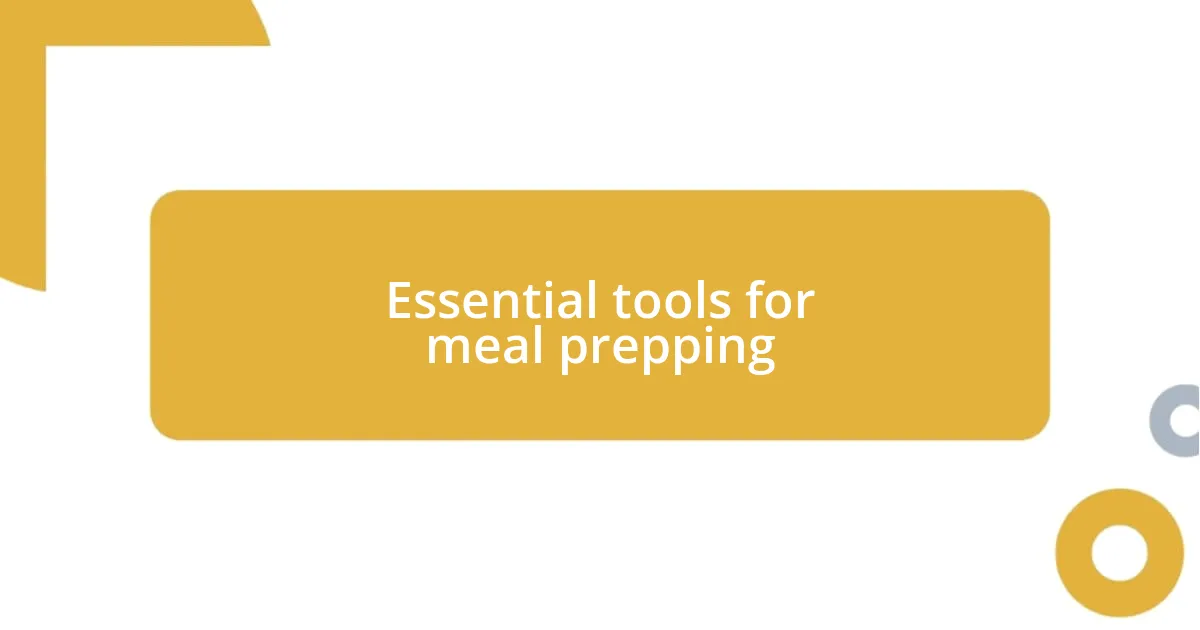
Essential tools for meal prepping
When it comes to meal prepping, having the right tools can make a world of difference. I’ve learned through trial and error that investing in a few key items not only simplifies the process but also enhances my cooking experience. For example, a high-quality set of glass containers has completely changed the way I store my meals. They not only look beautiful, but they also keep food fresh longer, reducing the likelihood of waste.
Here’s a quick list of essential tools that I recommend for effective meal prepping:
- Glass storage containers: Durable and eco-friendly, they’re perfect for keeping meals fresh.
- Mason jars: Ideal for salads, smoothies, and overnight oats, plus they lend a rustic charm.
- Food scale: Helps with portion control, ensuring I don’t over- or under-prepare meals.
- Chopping board and knives: A good set makes prep efficient and enjoyable.
- Slow cooker or Instant Pot: Incredibly versatile, they allow for easy batch cooking with minimal effort.
I find that these tools not only streamline my meal prep process but also cultivate a sense of joy in the kitchen. The rhythmic chopping of vegetables and the satisfying organization of my fridge brings a little slice of calm to my busy week. It’s in these moments that I truly appreciate the benefits of being prepared, turning meal prep from a chore into a delightful ritual.
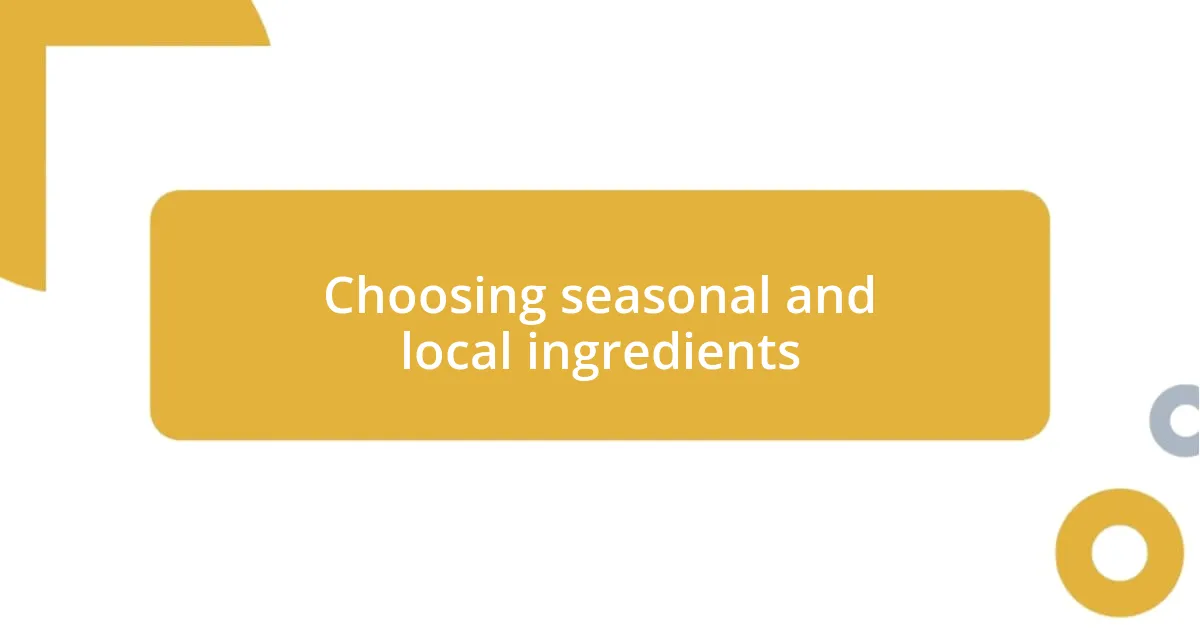
Choosing seasonal and local ingredients
When I think about choosing seasonal and local ingredients, I can’t help but recall a sunny Saturday morning spent at my local farmers’ market. There’s something invigorating about seeing fruits and vegetables in their prime—vibrant, fresh, and bursting with flavor. By opting for what’s in season, I not only support local farmers but also enjoy produce at its peak taste and nutrition. Isn’t it amazing how much better a ripe tomato or a crisp apple can taste compared to those shipped from halfway around the world?
Another aspect I cherish about local ingredients is the sense of community it fosters. As I chat with the farmers and learn the stories behind their goods, I feel a deeper connection to my food. These interactions often inspire me to incorporate more creativity in my meal prep. I remember one time I discovered a unique heirloom squash variety that wasn’t just beautiful to look at but also elevated my ravioli dish to a whole new level. It made me think—what hidden gems can I uncover next time?
Furthermore, the environmental impact of choosing seasonal and local ingredients resonates deeply with me. It minimizes the carbon footprint associated with transporting food over long distances. I feel proud knowing that my meal preparation can contribute to sustainability. Have you ever reflected on how your food choices impact the planet? By focusing on local options, I find a sense of fulfillment in knowing that I’m playing a small part in promoting a healthier environment while nourishing my body with high-quality ingredients. It feels like a win-win!
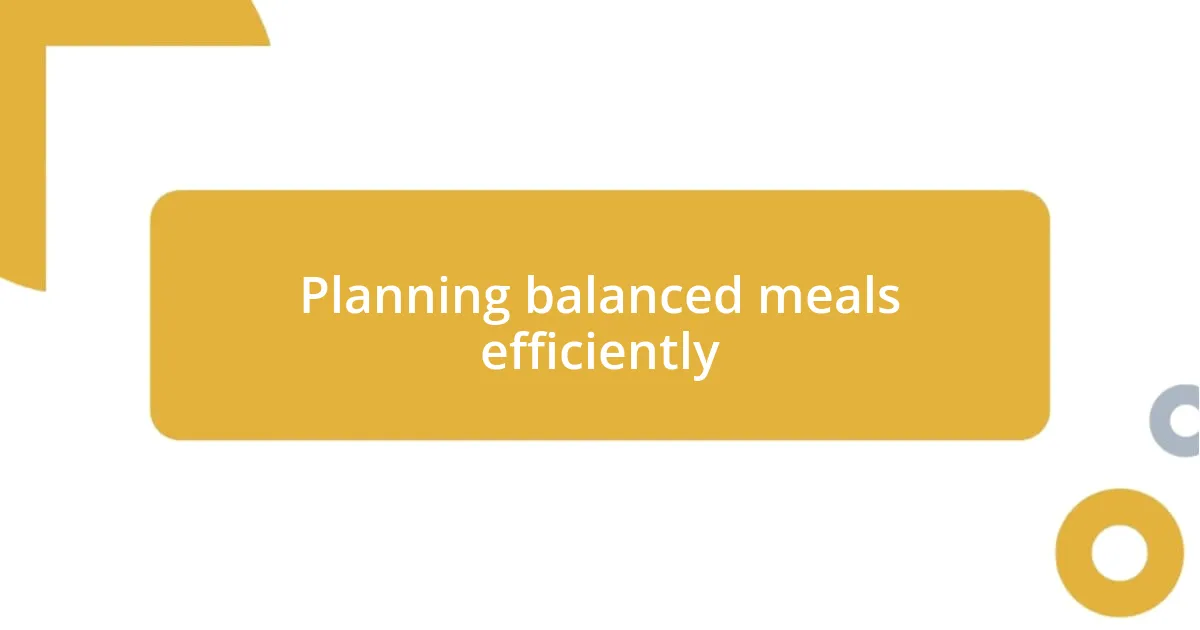
Planning balanced meals efficiently
The first step I take in planning balanced meals efficiently is to create a flexible menu for the week. This has been a game-changer for me. By jotting down meals that incorporate a variety of proteins, whole grains, and plenty of vegetables, I ensure that I’m meeting my nutritional needs without feeling overwhelmed. Have you ever noticed how a little structure can cut down on decision fatigue?
I like to set aside time on Sundays for this planning ritual, which honestly feels rewarding. I can mix and match meals, ensuring I have options for both quick lunches and hearty dinners. For instance, last week, I made a big batch of quinoa and roasted some seasonal veggies. They became a versatile base that I could pair with different proteins throughout the week. It was like creating a mini buffet in my fridge, and it felt fantastic!
To maximize efficiency, I also try to prep ingredients in bulk. For example, I often grill or bake a few chicken breasts at once and keep them on hand for salads or wraps. This not only saves time on busy weeknights but also helps me stay committed to healthy choices. Have you ever had those evenings when takeout feels like the only option? By having prepared ingredients ready to go, I’ve found I can avoid those last-minute temptations while also enjoying delicious home-cooked meals. Isn’t it empowering to know that a little planning can pave the way to healthier eating habits?
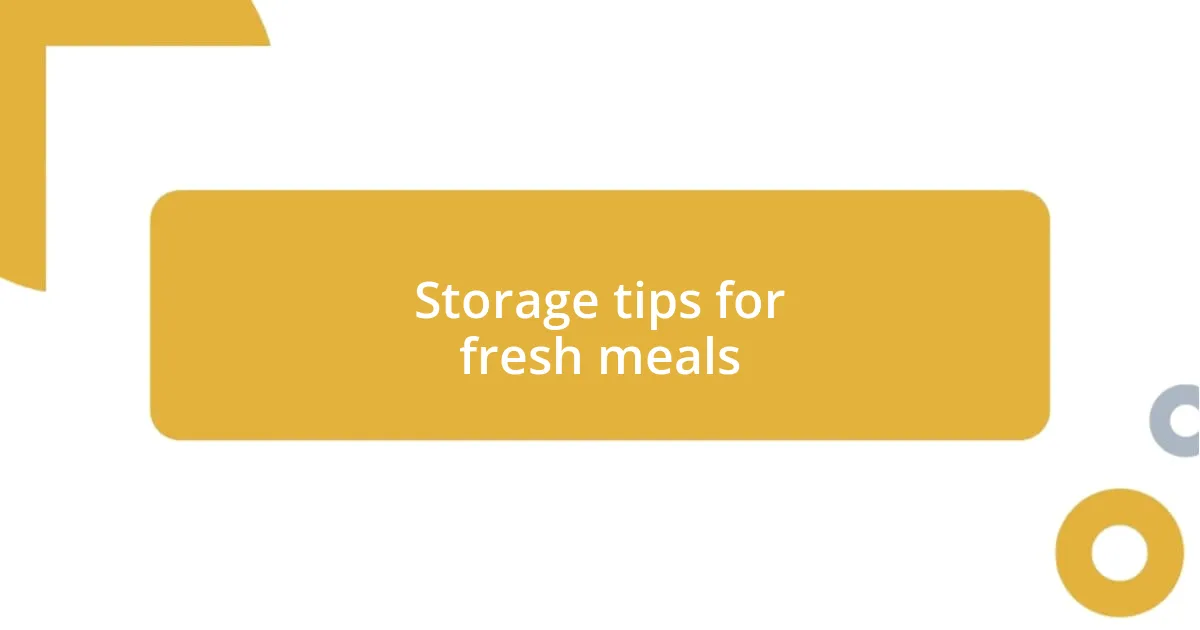
Storage tips for fresh meals
When it comes to storing fresh meals, I always prioritize using airtight containers. I remember a time when I had high hopes for a batch of stir-fried veggies, only to find them soggy and unappetizing the next day because I didn’t seal them properly. There’s nothing worse than feeling like a meal has gone to waste, especially when I put in the effort to prepare it. So now, I make it a point to invest in good-quality containers that prevent air from getting in and keep my food crispy and fresh.
Another clever trick I use is to label my containers with dates. I’ve learned the hard way that it’s easy to forget when I made something, and directing my attention to meals that need to be consumed soon can prevent uneaten food from piling up. Plus, these little labels have become a fun way for me to get creative—you’d be surprised how a simple doodle can brighten your day when you’re rummaging through the fridge.
I also like to store herbs in water, almost like a bouquet. This technique keeps them fresh for longer, and I can’t tell you how satisfying it feels to open my fridge and see a bunch of vibrant basil or cilantro waiting for my next culinary creation. It’s like having a mini-garden right in my kitchen! Have you tried this? It not only enhances the flavor of my meals but also adds color and brightness to my meal prep routine.
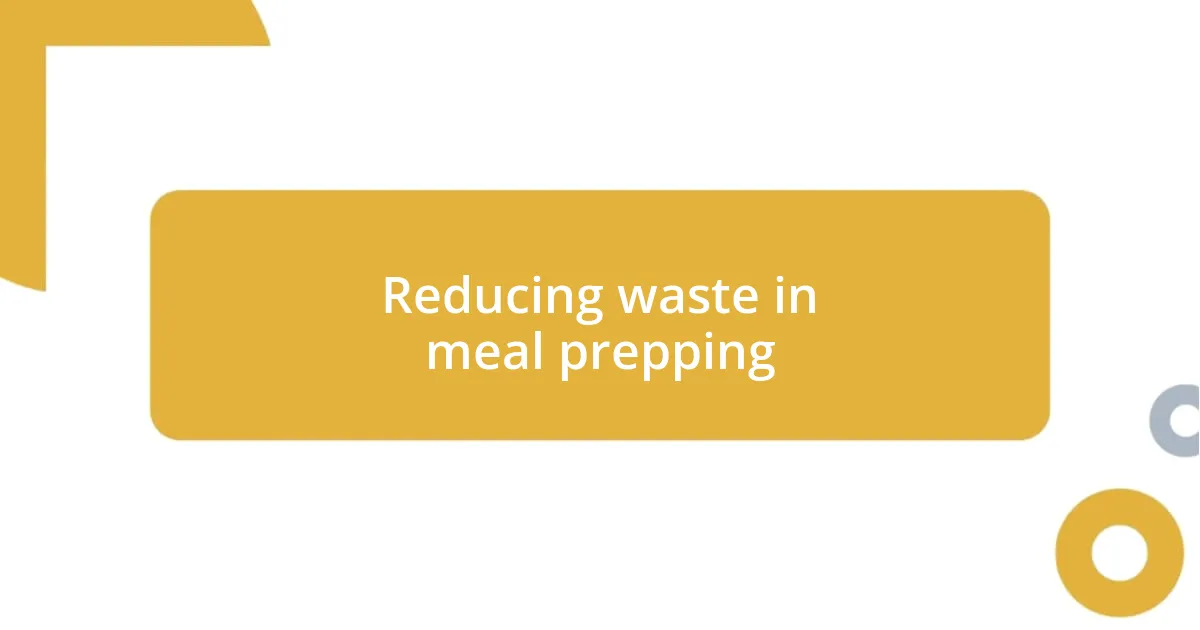
Reducing waste in meal prepping
Reducing waste during meal prep has become an essential aspect of my cooking routine. One method that has really resonated with me is using vegetable scraps to create homemade vegetable broth. I remember the first time I saved onion skins, carrot tops, and celery ends, throwing them into a pot. Not only did it feel rewarding to make something out of what I usually discarded, but I was also left with a flavorful broth that added richness to my soups and stews. Have you ever tried this? It’s a simple step that turns potential waste into something nourishing and delicious.
Another key strategy is to be mindful of portion sizes. Early on in my meal prep journey, I often found myself overestimating how much I could eat, leading to leftovers that eventually became compost. Now, I’ve learned to adjust my recipes based on what I know I can consume. I often make a point to measure out servings before cooking. It not only cuts down on waste but also helps me maintain a balanced approach to what I eat. Isn’t it interesting how being honest with ourselves about our appetite can lead to a more sustainable kitchen?
I’ve also found that repurposing leftovers has turned into one of my favorite culinary challenges. For instance, if I make a roast chicken, I’ll save the carcass and any meat scraps to whip up a comforting chicken noodle soup a few days later. It’s a creative way to ensure nothing goes to waste while bringing a new dish to the table. Doesn’t it feel great to transform one meal into another? This kind of ingenuity not only minimizes waste but also keeps my meals exciting, and I can honestly say, it’s sparked my creativity in the kitchen more than I ever anticipated!










